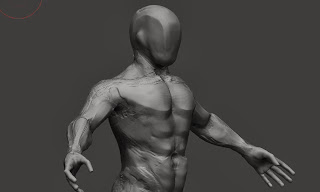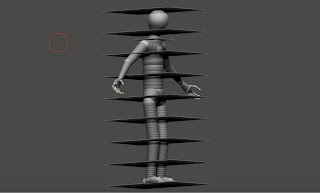This was the most relaxing part of the project. The BPR tool in Zbrush is a fairly new system which allows you to render out different passes of the figure and compose them together in post using a programme such as photoshop. In this case I rendered out an ambient occlusion, shadow, master beauty, a mask, and a depth pass. My favourite pass to play around with was the depth because it allowed me to play with the lens blur effect in photoshop, giving some good realistic results.
I used a matcap shader with a clay finish and applied it to the models. I wanted the eyes to stand out so I applied a basic material 2 shader to that. This gave the eyes a more shinier feel to it. Ultimately I wanted the renders to look like they were clay sculptures and I was pretty happy with the result.
To present the models I also sculpted something more realistic as a base for the models to stand on besides the usual box or cylinder. For the female I wanted something to accompany her sexuality, so I thought a silk cloth would be good for this. For the man I wanted something heroic and manly. This got me thinking about creating sky scrapers, however I wanted something simple so I just sculpted a rock. This still proved effective in my opinion.
Overall I was pretty happy with my success with this project. I learnt alot about the way the human body is shaped and sculpted and drawn. I wish i could name all the muscles off by heart but I would probably be able to name a handful at most. However whats important is that I know, at least, sub consciously, how the body looks, and have a deeper appreciation for it. The names of each muscle will come in time.
The last few weeks were, admittedly, rushed to an extent. I ended up having to fit in 3 weeks within one week, however it proved pretty achievable as I tend to work more efficiently near the end of tri.
The female figure was not a part of the original weekly tasks, and it is something that I do not regret doing. Doing the original plan meant doing 3 male poses, and this would just be exhausting after a while. Sculpting and posing the female was a refreshing experience and rejuvenated the project for me in a sense.
I hope you all enjoyed my journey to discovering the human body and I will try to keep updating my progress with things that I continue to learn along the away.


















































